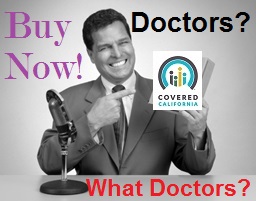
Covered California promotes sales over consumer interests.
From the earliest marketing of Covered California it was obvious that this new health insurance Marketplace exchange would be more of a sales organization as opposed to a consumer advocate for health insurance. A recently published document entitled Sales and Outreach Skills directed toward Certified Enrollment Counselors and Navigators reinforces the appearance that Covered California views itself as a sales organization. The emphasis of the sales brief is on how to close the sale and not on matching the consumer with the best health plan. Down the Covered California sales guide at the end of the post.
The Covered California elevator pitch
The Covered California Advance Study Course: Sales and Outreach Skills has sections titled
- The Seven Steps of the Sales Cycle
- How to Deliver an Elevator Pitch
- Developing an Adaptable Sales and Outreach Strategy
- How to Lead the Consumer to Take Action
- Following Up and Generating Referrals
Sell – Team – Sell
All of these sections could have been lifted from a Sales 101 manual for a boiler room sales operations. While I have no problem with Covered California introducing enrollment counselors to the basic flow of presenting the concept of health insurance, its necessity for families, and the various health plans offered, their approach leans toward producing a high volume of sales versus quality enrollments. As Covered California’s Executive Director Peter Lee has repeated many times, “health insurance is complicated”. When an organization focuses solely on hitting their enrollment numbers the quality of those enrollments will suffer.
Doctors? What Doctors?
Absent from the Covered California sales template are the first three questions that should be asked of someone interested in purchasing health insurance.
- Who are your trusted doctors you want to see?
- Which hospitals, clinics or facilities do you want to keep?
- What prescription medications do you need coverage for?
Any discussion of health insurance that doesn’t address these questions is a waste of time. But these are the questions that take time to research and slow down sales. They are also the important questions that lead to enrollments were the consumer is very satisfied and comfortable with their selection.
What’s a MOOP?
To be fair, there are many sections in the Covered California sales guide that address the coverage, benefits, and costs of the various health plan metal tiers. However, if you are going to have a discussion about the Cost Sharing Reduction of the Enhanced Silver plans; it would be wise to educate the consumer on the equally important nuts and bolts of health insurance. Before anyone begins to make a presentation about health insurance they should be able to answer the following question.
- What is the difference between in-network and out-of-network providers?
- What is the difference between an EPO, HMO, HSP, and PPO?
- What is the difference between copayments and coinsurance?
- What is the Maximum out of Pocket (MOOP) amount for each plan?
- How is the Advance Premium Tax Credit Calculated?
- How is the Maximum out of Pocket calculated?
- What is the Modified Adjusted Gross Income?
- What is a deductible and when does it apply?
- What is a Health Savings Account?
- What is a pharmacy deductible?
- What is a drug formulary?
- What is a 1095-A?
Put the consumer first, not the sale
Similar to researching the consumers preferred providers and whether their prescription medications are covered in the drug formulary of a preferred plan, all the above questions take time to answer. But if these questions aren’t at least addressed in some fashion the Certified Insurance Agent or Certified Enrollment Counselor is setting up the consumer for some unpleasant surprises in the future. To approach health insurance enrollment as a sales game, as Covered California has moved to in this sales guide, is a failure advocate on the part of consumers to help them make the best decision.
Insurance solicitation
The other troubling aspect of the Covered California Sales and Outreach guide is that it outlines how to solicit, sell and transact and insurance sale. The California Department of Insurance has fairly strict definitions when it comes to who can actually sell insurance.
Authorizing Act with Definitions
Sections 1626 (a)(2) of the California Insurance Code states, “Accident and health, which license shall entitle the licensee to transact insurance coverage for sickness, bodily injury, or accidental death and may include benefits for disability income.”
I completely understand that Covered California has gotten a pass on having to adhere to the strict definition of insurance sales because they are only “enrolling” individuals and families. However, their interactions with potential consumers exceed the passive online quoting and enrollment websites run by agents for which the agent must have an insurance license to operate.
It’s all a numbers game
Thousands of individuals and families have enrolled for tax subsidized health insurance through Covered California with absolutely no problems…and I’m happy about that. I also acknowledge that Covered California needs the fees associated with those enrollments to meet their budget in 2015 as they must be a self-sustaining organization. Unfortunately, in their zeal to pump up their sales and hit their numbers, they are encouraging sales practices that put sales goals ahead of consumer interests.
Download the Sale and Outreach Skills Guide from Covered California.
- [wpfilebase tag=fileurl id=452 linktext=’Covered California Sales and Outreach Skills Guide’ /]


